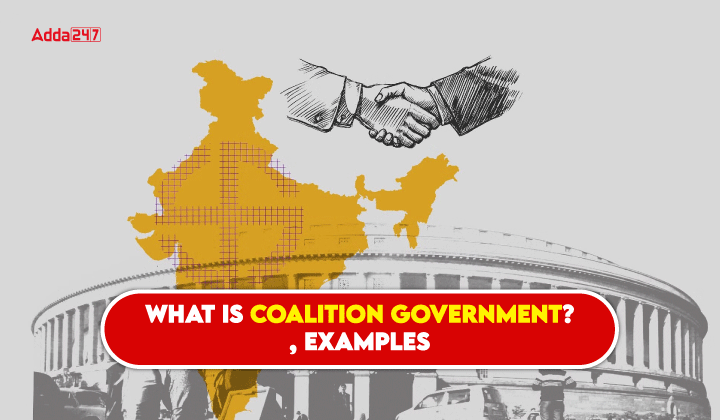Table of Contents
In a democracy, a Coalition government is often seen as a response to political diversity, representing a collective of political parties working together to form and sustain governance. India, being one of the world’s largest democracies, has experienced numerous coalition governments at both the National and State levels. This article delves into the concept of coalition governments, their characteristics, notable examples, and the legal framework around them, highlighting key case studies that demonstrate the challenges and successes of coalition politics in India.
What is Coalition Government?
A Coalition government is formed when multiple political parties agree to collaborate to govern a country or State. This type of government typically arises when no single party wins a clear majority in elections, leading to an alliance of parties that collectively command enough legislative seats to form the government. The term “coalition” is derived from the Latin word “coalitio,” meaning “to grow together,” signifying the unification of parties with diverse ideologies and goals into a temporary arrangement for governance.
In India, coalition governments became more prominent after the 1989 elections, following the decline of the Congress Party’s dominance. Coalition governance is now common, reflecting the country’s fragmented political landscape, where regional parties play a vital role alongside National parties.
Coalition Governments Formed in India
Coalition governments have been a recurring theme in Indian politics since the 1980s. Notable examples include:
- National Democratic Alliance (NDA) in 1999: The Bharatiya Janata Party (BJP), under the leadership of Atal Bihari Vajpayee, formed the first successful coalition government that completed its full term from 1999 to 2004.
- United Progressive Alliance (UPA) in 2004 and 2009: Led by the Indian National Congress under Manmohan Singh, the UPA managed to govern India through coalitions, primarily with the support of left-leaning parties.
Coalitions are not limited to National politics but are also seen at the State level, where regional parties often play a pivotal role in government formation.
Characteristics of Coalition Governments
Coalition governments have certain distinct characteristics that define their structure and functioning:
- Compromise and Negotiation: Coalition partners must often compromise on their policy agendas to reach a common program for governance. This often involves the drafting of a coalition agreement outlining the government’s key priorities.
- Power Sharing: The Cabinet is formed with representatives from all coalition parties, ensuring that power is distributed across the alliance.
- Instability: Coalition governments are inherently unstable due to the differences in ideologies among the partner parties, which can lead to internal conflict and, at times, the collapse of the government.
- Dynamic in Nature: Coalition politics is fluid, with alliances often shifting based on changing political scenarios or national crises.
Features of Coalition Government
The key features of Coalition governments are:
- Multiplicity of Parties: Coalition governments involve the participation of more than one political party, requiring the reconciliation of different political ideologies.
- Consensus Building: Decisions are typically made by consensus among the coalition partners, which may slow down the decision-making process but ensures broader representation.
- Representation of Regional Interests: In India, coalition governments often include regional parties that advocate for the interests of specific states, giving them a platform in national governance.
- Minimum Common Program: Coalition governments operate on a shared minimum program that may not fully satisfy all partners but is necessary to maintain the coalition’s stability.
Example of a Coalition Government
One of the most prominent examples of a coalition government in India is the National Democratic Alliance (NDA), led by the BJP under Atal Bihari Vajpayee from 1999 to 2004. This government completed its term despite the diverse political ideologies of its partner parties. The NDA’s governance set a precedent for the effectiveness of coalition governments in India.
Similarly, the United Progressive Alliance (UPA), led by the Indian National Congress from 2004 to 2014, was another successful coalition. Despite occasional internal strife, the UPA implemented significant reforms, such as the Right to Information Act (RTI) and the Mahatma Gandhi National Rural Employment Guarantee Act (MGNREGA).
Coalition Governments Case Studies
- S. R. Bommai vs Union of India (1994)
The landmark case of S. R. Bommai vs Union of India dealt with the imposition of President’s Rule in states with coalition governments. The Supreme Court laid down guidelines on how the President’s Rule can be imposed and under what circumstances. The case reinforced the stability of coalition governments by ensuring that the central government could not dismiss state governments on flimsy grounds. This case is significant as it highlighted the legal protections available to coalition governments in India. - Shiv Sena-BJP Coalition in Maharashtra (2019)
Another case study is the formation of the government in Maharashtra in 2019. After the assembly elections, despite a pre-poll alliance between the BJP and Shiv Sena, disagreements over power-sharing led to the collapse of their coalition. Eventually, Shiv Sena formed a coalition with the Nationalist Congress Party (NCP) and the Congress, demonstrating the fragility and shifting nature of coalition politics.
Conclusion
Coalition governments are now an integral part of Indian democracy. While they present challenges such as instability and compromises, they also provide a platform for broader representation and inclusion of regional interests. Legal protections and case law, like the S. R. Bommai case, ensure that coalition governments are safeguarded from arbitrary dismissals. As India continues to evolve politically, coalition governments will likely remain a crucial aspect of governance, reflecting the country’s diverse political landscape.



 TSPSC Group 1 Question Paper 2024, Downl...
TSPSC Group 1 Question Paper 2024, Downl...
 TSPSC Group 1 Answer key 2024 Out, Downl...
TSPSC Group 1 Answer key 2024 Out, Downl...
 UPSC Prelims 2024 Question Paper, Downlo...
UPSC Prelims 2024 Question Paper, Downlo...





